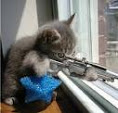(Part 1 and 2)
Air defense in a battle group was controlled by the Anti-Air Warfare Commander (AW), known by the radio call sign "Alfa Whiskey". The officer who was Alfa Whisky was usually either the battle group commander himself or a member of his staff, but not always. If a guided missile cruiser impressed the battle group commander as having its shit together, then the cruiser's CO would be AW. In the former case, the battle group watch officer would be the AW watch officer. In the latter case, the cruiser's TAO would be the AW watch officer. AW controlled the entire air defense for the battle group, including the air-defense weaponry and sensors of all of the ships. The fighters assigned to Combat Air Patrol worked for AW, as did the E-2s. A ship could not disable any AAW sensor or weapon for maintenance without the permission of AW.
The key player in an air-defense situation was the Anti-Air Warfare Cooordinator, or AAWC. The AAWC sat at a NTDS-equipped scope. AAWC would designate targets by both NTS and by VHF unsecured radio, for when it got to that point, the need for speed overrode the need for security. How much the AAWC had to command depended on the warning condition.
There were three warning conditions: WARNING RED, WARNING YELLOW, and WARNING WHITE. They described the risk of an air attack on the battle group. (I never saw WARNING RED outside of an exercise scenario.) There were two weapons readiness conditions: WEAPONS TIGHT and WEAPONS FREE. They could be battle-group wide, assigned to one ship or CAP or even assigned to one ship and one radar track. Ships might be assigned certain compass arc within which they were WEAPONS FREE and outside of which they were WEAPONS TIGHT. Anti-air missiles were a very limited resource for any battle group; it was vitally important that there not be multiple ships shooting at the same target.
The overriding principle for command of the AAW battle was "control by negation." Within the parameters of the warning and weapons conditions, the ships and CAP could do what they wanted and if AW or the AAWC had a problem with that, they'd let you know. AW usually published guidelines determining which ship had radar picket duty if there was no E-2 coverage. Radar emissions control fell to AW.
The two primary air defense radars in the pre-AEGIS days were the SPS-40 and the SPS-48. The SPS-40 was a 2D radar (range and bearing information only), it was found on virtually every warship larger than a patrol boat. The SPS-48 was a 3D radar, it was found on virtually every ship capable of more than basic point defense. (By some quirk of the numbering system, the SPS-48 replaced the SPS-52.) Both radars scanned for range and bearing by mechanically rotating the antenna, the -48 electronically scanned for altitude (the antenna did not move vertically).
(All this, by the way, is pre-AEGIS.)
The Inferno Awaits
20 hours ago

4 comments:
Fascinating, as always, Comrade! Will you be explaining AEGIS in a future post?
No, for I know very little about it. I am writing, in this blog, largely about stuff I know from having lived through it.
Wow! You lived through a fuckton of Naval shit!
Fantastic goods from you, man. I have understand your stuff previous to and
you're just extremely fantastic. I actually like what
you've acquired here, really like what you are stating and the way in which
you say it. You make it entertaining and you still take care of to keep it sensible.
I can not wait to read far more from you.
This is really a tremendous site.
Post a Comment